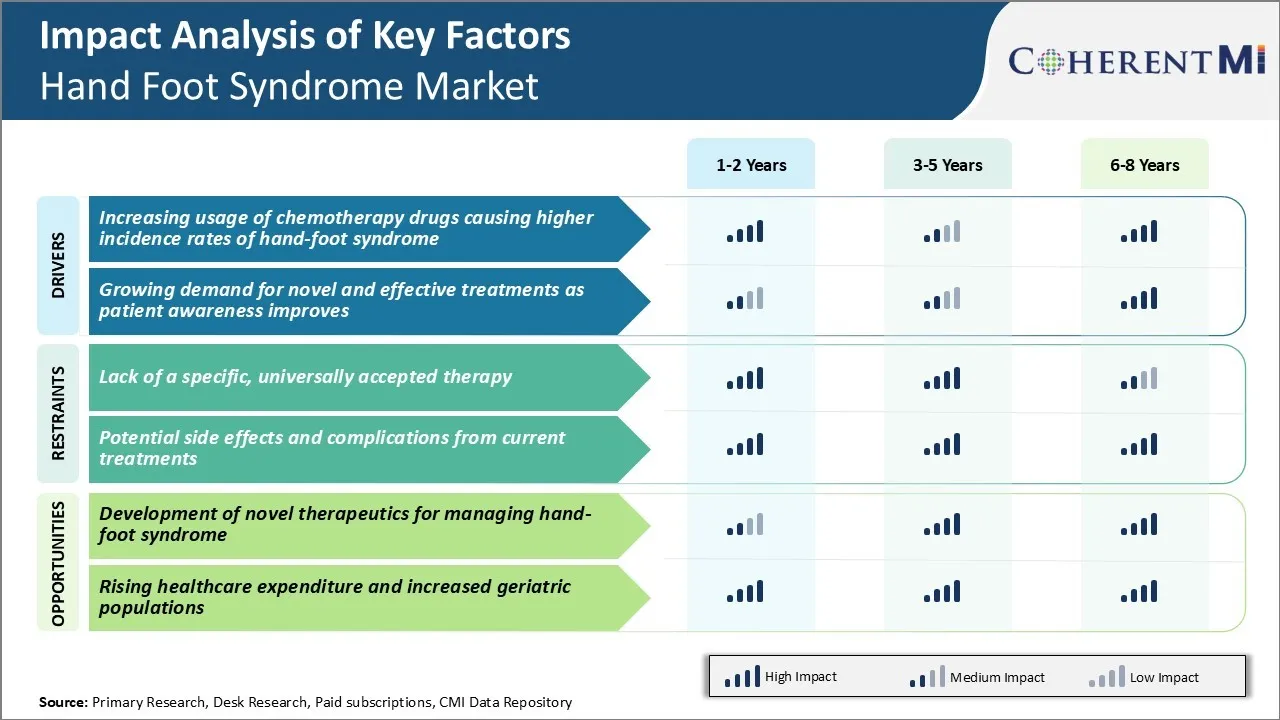Hand Foot Syndrome Market Trends
Market Driver - Increasing Usage of Chemotherapy Drugs Causing Higher Incidence Rates of Hand-Foot Syndrome
As cancer being one of the leading causes of mortality worldwide, the need for effective treatment methods has grown exponentially. Chemotherapy has established itself as one of the foremost lines of treatment against cancer, successfully able to extend lives and achieve remission. However, chemotherapy drugs are not without side effects and one such common side effect is hand-foot syndrome.
As per studies, incidence rates of hand-foot syndrome vary based on type of chemotherapy drug used as well as dosage levels but generally fall in the range of 20-40%. For drugs like capecitabine and liposomal doxorubicin, incidences as high as 50-60% have also been reported. The high risk associated with these frequently used drugs means exposure of large patient base to chances of developing hand-foot syndrome.
With global cancer figures projected to continue ascension in coming years owing to aging population and lifestyle changes, chemotherapy treatments shall remain indispensable. This will maintain pressure on drug manufacturers as well as health systems to effectively manage the side effects. As long as chemotherapy usage remains predominant, related adverse effects like hand foot syndrome will persist as a challenge.
Market Driver - Growing Awareness and Demand for Improved Treatment Options
With rising cases of cancer worldwide, greater efforts are being made to enhance awareness among general public as well as medical community regarding the disease and available treatment protocols. This encompasses not just spreading knowledge about the illness itself but also shedding light on common side effects experienced.
Hand-foot syndrome, as one such side effect of selected chemotherapy drugs, has seen increased visibility through various cancer support groups and advocacy platforms. Patients are more informed now about the possibility of developing skin irritations on hands and feet during or after chemotherapy cycles.
Patients look for over-the-counter as well as prescription-based remedies to ease pain, inflammation, swelling and discomfort caused. They also closely follow research on newer drug candidates under investigation. Considering that available treatment choices have shown limitations, the void has created demand for more target-specific and efficacious treatment approaches. Pharmaceutical companies are responding to such needs of patients and healthcare providers by conducting extensive R&D towards development of novel and safe treatment solutions. Support groups chip in as well to support clinical trials through volunteer participation as well as funding support.

Market Challenge - Lack of a Specific, Universally Accepted Therapy
Hand foot syndrome is a challenging side effect to treat as there remains a lack of a specific, universally accepted therapy for its management. While various treatments have shown some effectiveness, such as topical drugs, supportive care, or dose reductions of the causative cancer drugs, physicians still struggle to prevent its occurrence or adequately treat established cases.
No current options have demonstrated clear superiority over others or provided long lasting relief for patients. This uncertainty surrounding the optimal treatment approach leads to inconsistent care for patients and difficulty designing clinical trials.
Developing new therapeutic strategies is hindered by the lack of biological insight into the root causes of hand foot syndrome. With many cases still resulting in severe pain and blistering, there remains a clear unmet need to identify more reliable and protective therapies to help improve quality of life for the many cancer patients impacted by this debilitating side effect.
Market Opportunity - Development of Novel Therapeutics for Managing Hand-Foot Syndrome
The current lack of effective therapeutic options for hand-foot syndrome presents a major market opportunity for developing novel drug candidates. Successful introduction of new medications that can reliably prevent onset or rapidly resolve symptoms would capture significant market share by addressing this significant unmet medical need.
In particular, targeted, mechanism-based treatments offer the strongest potential to achieve superior efficacy over non-specific supportive care approaches. Proof of meaningful clinical benefit over existing standard of care options could also support premium pricing, reflecting the impact on patient wellbeing and costs of alternative treatments.
Additionally, novel biological insights enabling patient stratification hold promise to elucidate the pathophysiology of vulnerable subsets and their differing response to investigational therapies. Such precision medicine approaches may accelerate clinical development by enriching enrollment for responsive patient populations most likely to benefit.
Overall, the clear lack of existing therapeutic standards indicates a wide-open, hand foot syndrome market for innovative new treatments able to transform management of this debilitating oncology side effect.